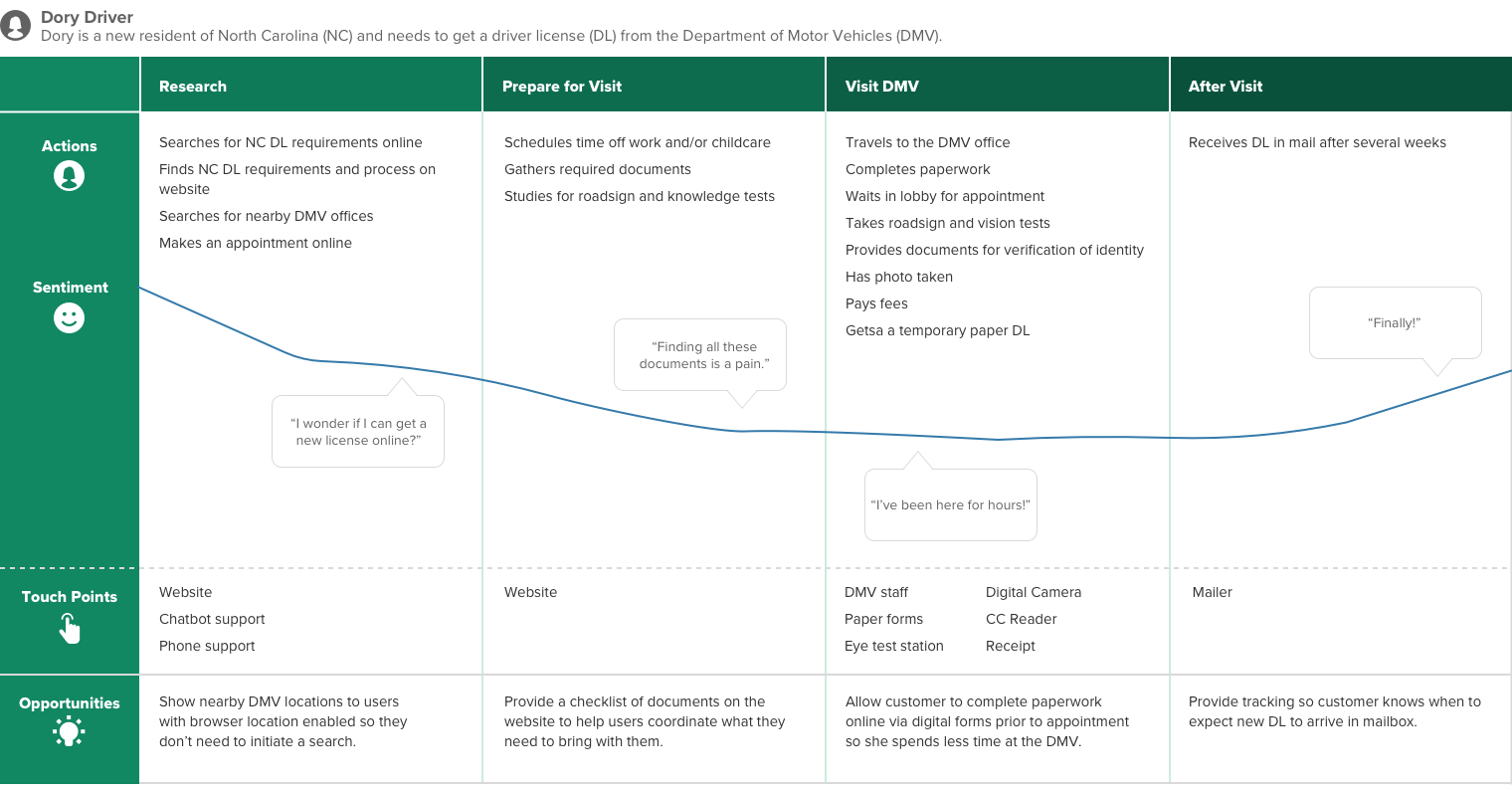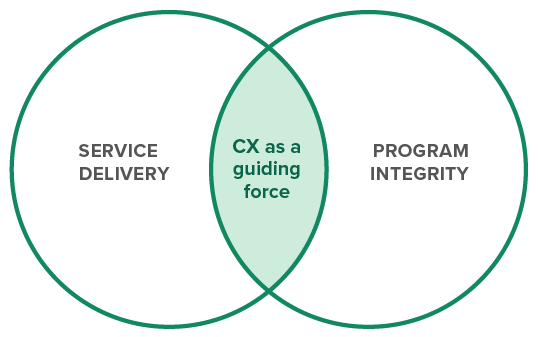Using CX to align goals for improved service delivery
At the core of this work is a focus on designing for people’s needs and the customer experience (CX). We believe CX can play an important role in government modernization. But we also believe that it should serve as more of an active “sense and respond” function that helps agencies reduce friction to service delivery, rather than just a passive reporting role.
CX by definition
CX is widely described as an individual’s perception of all their interactions with an organization. It originated in the private sector and is used by many companies today to manage their brands and deliver positive customer experiences. It’s also one of the top 3 priorities in the Biden-Harris Management Agenda and the subject of bipartisan legislation in the House and Senate. Since CX is focused on how people interact with an organization as a whole, it’s broader than a single interaction with a given product, service, or touchpoint.
As agencies of all kinds seek to modernize and deliver more services digitally, CX can help them better understand how ecosystems of people, process, and technology can evolve to better serve people. In particular, a strong CX discipline can help agencies understand key interactions over a person’s lifetime, not just a singular experience. It can also enable organizations to be more data-driven and consider how digital and non-digital channels — like websites, field offices, and call centers — need to work together.

Translating private sector techniques to public services
Most modern digital practices originate from the private sector but must be adapted to meet the unique needs of the public sector. For example, consider product management, which helps organizations identify the right problems to solve and iteratively shape solutions based on evidence, rather than assumptions. Product management is increasingly central to how agencies deliver services, but it also brings with it concepts like “finding product market” that don’t apply to the government without translation. Agencies don’t get to pick and choose their markets; instead they often start with a mandate and must adapt product-oriented techniques to best meet the needs of people and policy.
The same is true with CX, in that companies use these techniques to improve how they serve customers but also to drive customer acquisition, engagement, retention, and other business-oriented metrics. Facebook wants to drive people to their various apps and keep them there as part of their business model. But the government is not a business. Rather, its goal is to serve people in ways that are effective, usable, and that inspire trust. This means that agencies shouldn’t always try to build technology in exactly the same ways as modern tech companies. It also means that good CX in government might look different from the private sector.
Challenges and opportunities for evolving CX in government
There are many great CX leaders in government today who are truly transforming how agencies serve people. But too often, CX is reduced to a passive reporting function that focuses on lagging indicators, like measuring “public trust in government,” rather than leading indicators of successful service delivery. By focusing more on both sets of metrics, agencies will be better able to inform and respond to priorities that drive the customer experience.
Angelo Frigo, CX expert and former Presidential Innovation Fellow, writes about these ideas and why agencies should focus more on burden reduction in his article “Why CX in government is not performing as well as in the private sector.” He states that setting target goals for burden reduction will encourage government agencies to refocus their energy on understanding and improving customer experience as the private sector does.
But rather than focusing on burden reduction, one of the most prominent applications of CX in government today is helping agencies measure customer sentiment. This is often done by collecting customer survey data and comparing the results each year. This data can provide a wealth of information, but typically, the focus is on how much people trust the agency, with the expectation that if the agency is doing a good job, trust scores will go up.
While sentiment-related measures like trust can serve as a helpful north star that grabs people’s attention, they don’t necessarily help us understand what the key barriers to service delivery are or how to deal with them. Moreover, CX efforts focused around sentiment can be unreliable. People’s perception of an agency can change for any number of reasons that don’t involve the quality of service delivery, such as the various changes that come with a new presidential administration.
Instead, CX should serve as more of a directing force for agencies by spotlighting the key points of friction in the customer journey and guiding digital teams to the highest value opportunities. It should also be used to create new customer feedback loops that help agencies continuously learn and improve their services.

CX can also play a larger role in aligning internal teams so that agencies can better understand how to deliver effective customer experiences within the context of program and policy constraints. On this topic, we see two persistent challenges:
Balancing service delivery with program integrity
Government has the difficult position of delivering services that meet a wide range of people’s needs, while also meeting stringent policy and program goals. Now add to the challenge the fact that these goals are not always aligned but, instead, are often in competition.
We see this tension play out most often with public benefits programs like unemployment insurance (UI). During the height of the COVID-19 pandemic, we saw the nation’s outdated and fragile UI systems virtually collapse due to unprecedented demand. As a result of these failures, people who were otherwise eligible for unemployment checks couldn’t get them, while reports of fraud, waste, and abuse skyrocketed — mainly due to organized crime rings that specifically targeted these systems.
The Department of Labor is now leading an effort to modernize these systems, but it will ultimately need to balance making these services easier to access and use while also meeting legal and policy requirements. Doing so requires CX to bring a dual focus on improving service delivery while managing program integrity, as well as a data-informed perspective that helps organizations make informed tradeoffs.

Designing services based on what people need, rather than how agencies are organized
Agencies tend to deliver services in ways that are consistent with how they are organized internally – often in siloed offices – rather than what’s best for people.
This was one of the challenges we helped the Department of Veterans Affairs (VA) navigate as we worked together to design and launch VA.gov. By consolidating various department websites and legacy brands, we created a new “digital front door” that provides a single, cohesive experience for Veterans, their families, and caregivers. This helped minimize the time users spent navigating content and completing tasks, which created a more positive customer experience.
As the government creates new CX offices, it will be crucial that they’re empowered and equipped so that they can align agency functions to deliver effective services that adhere to program and policy goals. It will be equally crucial to remember that because the government is service-driven, CX is every employee’s responsibility. CX teams cannot operate effectively in a vacuum.
Case in point: In most agencies today, CXOs and CFOs have very little in common, even though they directly affect each other. They sometimes have competing goals and few real pathways to collaborate on shared initiatives. CX can help bridge this gap by serving as an agency’s connective tissue and directing its various functions to the highest value opportunities along the customer journey.
One such example of an organization that could immediately benefit from incorporating a CX strategy is the IRS, which increasingly operates as a customer-centric service delivery agency. A robust CX function could help teams proactively assess the impact of changes, like redesigning tax forms using plain language, which could affect payment accuracy and timeliness. With these CX-powered insights, the IRS could better weigh the costs and benefits of various approaches on both service delivery and program integrity and could ultimately innovate with greater confidence.
CX can help agencies identify, weigh, and manage trade-offs that span both service delivery and program integrity goals through iterative and data-driven techniques like prototyping and pilot programs. Arguably, this is where CX can make the most impact. It can center efforts to improve people’s experiences with the government on the reality of policy constraints. CX can then challenge those constraints through evidence-driven techniques that deliver real value for people. The key point to remember is that improving people’s experience with the government means getting them the information and services they need as efficiently and effectively as possible, and that is precisely what CX can help accomplish.
Serving people better
Government should continue to think of itself as a service provider, but one that increasingly interacts with people through digital channels. As a result, understanding how a person’s entire experience with different products, services, and methods affects their view of an agency is important for the government, but only so far as it helps them understand how they can better serve people.
Doing this would focus CX around what matters most: how the government serves people, and the leading indicators around that goal, such as reducing friction and burden to service delivery, rather than lagging indicators like trust.
How Ad Hoc can help
At Ad Hoc, we believe CX should serve as a directing force for agencies, one that helps digital teams in particular better understand where key difficulties are in the customer journey and how best to address them. CX can help unite different parts of an agency, especially customer service and compliance functions, by establishing shared goals and incorporating evidence-driven approaches like pilot programs. Doing so will help agencies understand the impact of CX improvements on program and policy goals.
If you’re interested in introducing CX to your agency, Ad Hoc can assist. Our cross-functional teams can help map the customer journey across your enterprise, identify key points of friction and opportunities, and run pilot programs that will help determine how to best address them.
Related posts
- The right benchmarks
- The 21st Century IDEA Act Playbook Part 2: Search, security, and serving users
- Research as Diplomacy: The marriage of research and product
- The impact of internal incentives on product outcomes
- How bad incentives can lead projects astray, and how to set things straight
- The case for listening to enterprise users